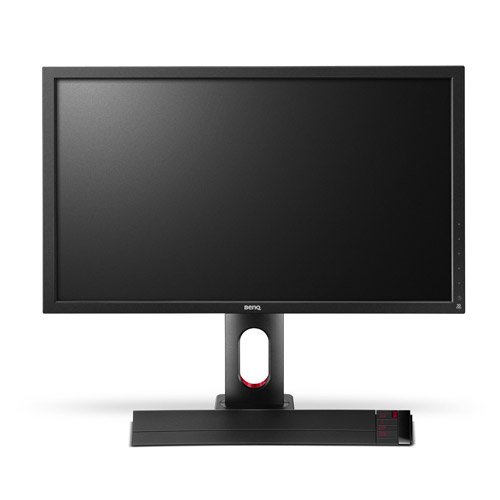FPS Gaming Monitor Guide
Raise your hand if you’ve been in this situation: it’s a 1-v-1 with only precious few seconds left to plant the bomb or your team loses.
As you sprint around a corner, you notice your lone enemy standing across the room. You both raise your guns in unison, hip firing straight at each other.
It looks like you both shoot at the same time and yet your character drops dead. You scream a few curse words and hurl your mouse at the wall, .
In the back of your head, you start to wonder: is your monitor holding you back?

First Person Shooter Monitor Requirements
There are 5 key features you need to consider when purchasing a first-person shooter gaming monitor.
- Resolution
- Refresh Rate
- Adaptive Sync
- Panel Tech
- Response Time
I’ll break down why each of these are important, what to look for, and then I’ve put together an updated list of perfect monitors for Call of Duty, Fortnite, CS:GO, PUBG, or any other FPS!
Resolution
This is the easiest and some might say the most important quality for a FPS gaming monitor: the display resolution.
Standard gaming monitors come in the following resolutions:
While bigger is usually better, especially for immersive gaming, that’s not what we’re going for here. If you look at professional FPS gamers on Twitch, be it Call of Duty to CS:GO to you name it, they’re almost always using smaller monitors that are most optimized for refresh and response time.
You obviously want as crisp and clear an image as possible while also pushing as much performance to your refresh and response time. A 1080 resolution does just that, which is why all of the best FPS gaming monitors are 24-27 inches in size. Even a mid-range graphics card should have no trouble smoothly running current FPS games.
Anything bigger and you’ll notice
Refresh Rate
When you’re playing a game, no matter what shooter it is, the situation is always changing. Players move, bullets are shot, things blow up – you name it, there’s a game that does it.
Monitors have to show all those changes, which means they’re constantly refreshing. A monitor’s refresh rate tells you how many times it can refresh your screen per second.
Most monitors today have one of the following refresh rates:
- 60Hz
- 144Hz
- 240Hz
Obviously, the more times a monitor is able to refresh, the more detailed information you’ll receive. This lets you “see” more.
For shooters, you want as high a refresh rate as your computer can hreandle.
Adaptive Sync
The two main graphics card makers are AMD and Nvidia. Each have their own adaptive sync technology to reduce screen tearing during gaming. Both adaptive tech synchronizes your monitor directly with your graphics card, which guarantees images always arrive on screen at the exact specif time. This is most noticeable in games where you quickly turn, as in jumping while turning 180 to shoot somebody behind you.
AMD calls their tech FreeSync while Nvidia uses G-Sync. The two options only work with their parent company, so if you have an AMD graphics card, a G-Sync monitor would be wasted on you.
While the reduction in screen tearing is nice, Adaptive Sync isn’t without it’s drawbacks. If you have a compatible Nvidia graphics card, then adding G-Sync to a first person shooter monitor will increase the price tag by at least $150.
However, FreeSync adds virtually no price to a monitor, which means it’s worth getting a FreeSync monitor if you have ANY compatible AMD graphics card! Thankfully AMD has a full database of every FreeSync monitor in case you want to see if you happen to
Since G-Sync adds such a premium, I’d only consider a G-Sync monitor if I already had a powerful Nvidia graphics card. Adaptive Sync is something you want to build around your graphics card, not the other way around. Honestly, I value this the least important of all 5 traits, but eliminating screen tearing will give you the slightest of edges.
Panel Tech
If you purchased a TV over the past 20 years, you’ll remember you had two options when it came to image quality: plasma or LCD.
Panel tech is the modern day equivalent for computer monitors!. These days, monitors rely on two main types of panel tech:
- TN (twisted nematic)
- IPS (in-plane switching)
Like the plasma vs LCD debate, both TN and IPS have their strengths and weaknesses. However, only one type of panel works for FPS games!
IPS screens look gorgeous and are found on high-end monitors. IPS benefits include a wide 178 degree viewing angel on the screen, allowing for an immersive gaming experience. However, all this beauty and wonder comes at a cost. IPS panels have lower response times, which is terrible for an FPS. If somebody kills you in Fortnite, are you happy to watch your body crumple onto a brighter, prettier shade of grass?
TN panels, on the other hand, trade a little bit of color rendering power for a higher refresh rate and lower cost.
This is why IPS monitors are more suiting for single player, RPG, or any non-FPS game. That means we want TN panel monitors for FPS games!
Response Time
The response time of an FPS gaming monitor needs to be as low as possible. Your monitor’s pixels measure how long they take to switch colors in milliseconds (ms) and currently, the fastest monitor response times are 1ms monitors.
ANY serious gaming event will have 100% monitors with 1ms response time. Any serious FPS gamer on Twitch has a 1ms
With a 1ms gaming monitor, the changing of colors on your screen will be as smooth as possible while the camera moves. With no blur, you cut down on vital seconds where you’re essentially blind.
In 2018, there’s really no excuse not to have a 1ms response time monitor. They’re cheap, they’re prevalent, and they’re the absolute best.
Best First Person Shooter Gaming Monitors
Continue below for a full breakdown of each FPS gaming monitor!
Template not found.BenQ XL2540 Gaming Monitor
It should come as no surprise that a BenQ monitor came in first, as they helped revolutionize how seriously gaming monitors can be. The XL2540 comes in as the top choice in our best FPS gaming monitor list for a variety of reasons. With a 144Hz refresh rate and 1ms response time, you’re guaranteed the faster possible picture to go along with an ultra smooth gaming experience.
It’s a bummer the XL2540 doesn’t have a Vesa mount. Thankfully, the build quality of the XL2540 monitor is well above average and comes built with a heavy, solid base so that it won’t fall over easily. To further boot, we loved the rotating, 90° spin that allowed for both horizontal and vertical alignment.
A nice touch are the side panels, which reduce both glare and peripheral distractions.
Setting up the BenQ out of the box is lightning fast, meaning you can get it up and running in just a few minutes. It also comes with software that you can install onto your computer that will allow you to adjust the brightness and contrast, along with other settings, that help give you the best possible picture while winning the battle royale or planting the bomb.
Template not found.AOC G2460PF Gaming Monitor
If you have an AMD graphics card, you’ll want to give strong consideration to the AOC G2460PF FPS gaming monitor! It’s great 24″ monitor with a 1ms response time and a 144hz refresh rate that spits out crisp, bright colors making games look absolutely gorgeous.
Another nice perk is the G2460PF comes equipped with a Vesa mount. This allows you to attach the monitor to any Vesa bracket, wall hanger, or mount to give you total control over positioning your monitor.
AMD Owners: Pay Attention
As we mentioned in our opening review, AMD Adaptive Sync tech is called FreeSync and is nice because it doesn’t add to the price. The G2460PF is the only monitor that passed our rigorous standards to also have FreeSync and it comes in at under $200!
As usual with our picks, this AOC FPS monitor has received great reviews from users playing Call of Duty, PUBG, or CS:GO. In fact, I’m an owner of this monitor myself! I use it to play Fortnite every weekend and it’s 👌
Template not found.ASUS VG248QE
If you’re looking to save a little money without skimping on any important features, then the ASUS VG248QE is the perfect solution for you.
The VG248QE has a Vesa mount and also boosts the highest average customer rating on our list.
Template not found.ASUS ROG PG258Q
The ASUS ROG PG258Q is the most expensive option on our best FPS monitors guide, but the reason is because it’s also the only monitor compatible with G-Sync, Nvidia’s Adaptive Sync technology! Like our earlier selections, you’ll be able to play FPS games in extremely high quality with this monitor.
Nvidia Owners: Pay Attention
As we mentioned in our opening review, Nvidia Adaptive Sync tech is called G-Sync. It’s nice to have, but adds around $100-$150 to a monitor’s price. If you purchase the PG258Q, you should also own an Nvidia graphics card.
Assuming you have an Nvidia GPU, then the PG258Q gaming monitor is worth your attention. The 24.5″ screen gives you just a hint more real estate on your 1920×1080 resolution, but the real kicker is the 240Hz refresh rate.
There’s no Vesa mount, but the customer reviews are through the roof on the PG258Q and it’s a great choice for the Nvidia gamers among us!
Template not found.BenQ ZOWIE XL2411P
The BenQ ZOWIE XL2411P is a wonderful CS:GO monitor that manages to sell at a budget price without sacrificing any important FPS qualities. From a crisp, beautiful 1920×1080 resolution with a TN panel, to a 144Hz refresh rate and a 1ms response time – it’s all there.
Literally everything you need in a PUBG monitor for under $200.
One cool thing about BenQ is they use low bluelight technology that provides an easy gaming experience on your eyes. This means you can slay in Call of Duty for hours with little to no eye fatigue!
If you’re looking for a budget gaming monitor than the BenQ XL2411P is definitely the one that’ll make you say ZOWIE.

….you’re right, that was bad, I’ll show myself the door.:D
Where was I? Or yes, the XL2411P has everything you could possibly want in a gaming monitor while remaining one of the cheapest on the market AND keeping the BenQ brand. It has multiple video connectivity options as well as built in stereo speakers, a solid frame, and plenty of online guides to help fine tune the settings out of the box so that it’s working perfectly on Call of Duty, Fortnite, or any other FPS game.
Template not found. Template not found.